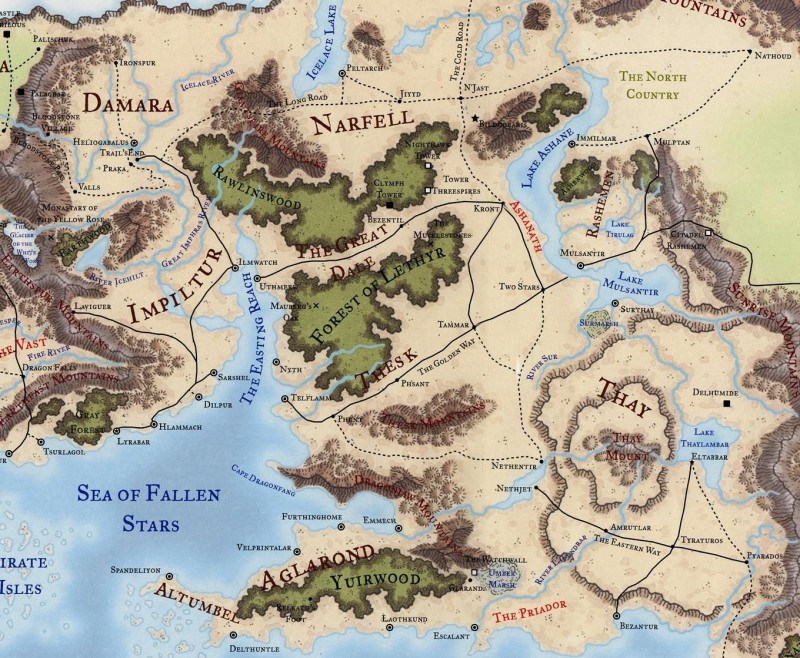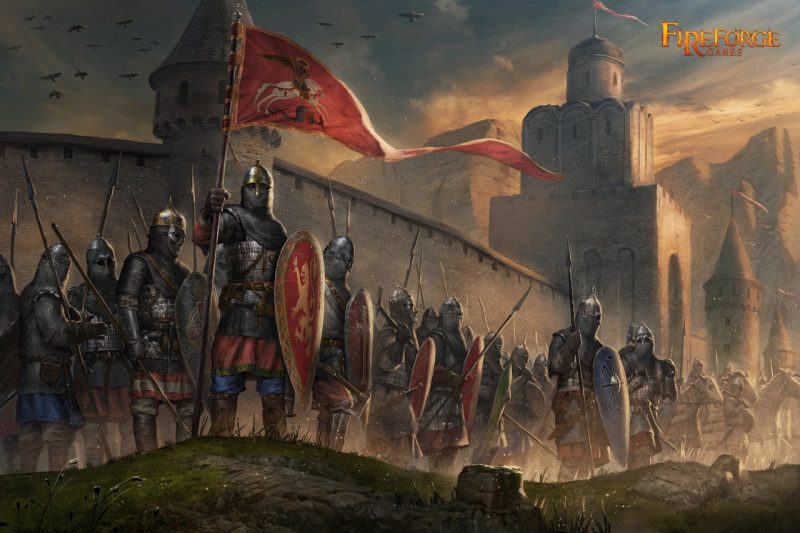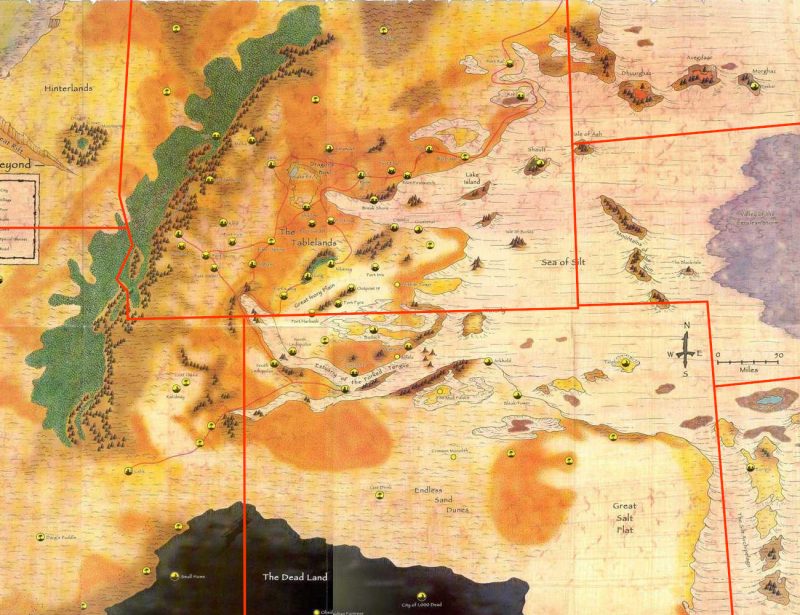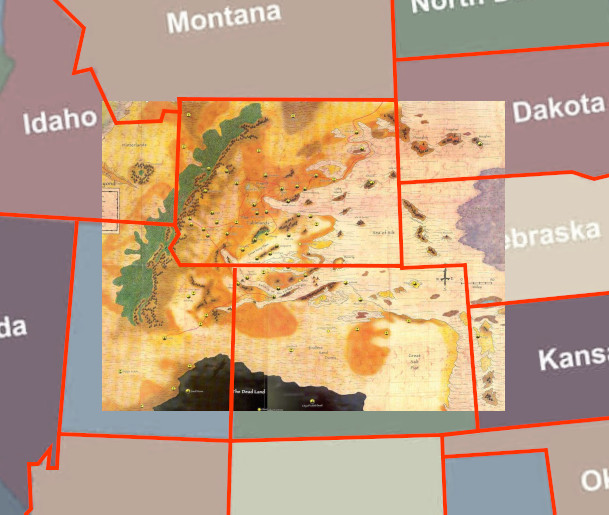As I mentioned occasionally in the past, I have a certain fascination with the Northeastern region of the Forgotten Realms. The third edition book The Unapproachable East is my second favorite setting book after The Savage Frontier, as I always found it very evocative and very well made.
“Traditionally”, Northeast Faerûn is treated as two broader regions. The Unapproachable East consisting of Rashemen, the Great Dale, Thesk, Aglarond, and Thay, and the Cold Lands consisting of Vaasa, Damara, and Narfell. However, I find these categorizations somewhat arbitrary and not really reflective of the political, economic, cultural, and geographic relationships that are implied by the maps and the descriptions of these lands.
While I keep using the name The Unapproachable East for the Northeastern region of Faerûn, the “natural borders” of the region that I see look more like this.
 Impiltur is nor usually considered part of the Unapproachable East, but most of its population and centers of power are in the port cities of the Easting Reach, which are close neighbors of the Great Dale and Thesk just across the water to the East. In contrast, the Vast and the Moonsea in the West are physically separated from Impiltur by the great Earthspur Mountains. While I can see how at a first look, the Easting Reach of the Sea of Fallen Star might seem like a natural border, what I am seeing is instead a natural highway that reminds me very much of the Baltic Sea, considering the cultural influences seen in the surrounding countries. In the medieval Baltic, the port cities had a much closer cultural and political relationship with each other than with their respective neighboring territories further inland. With that in mind, I see Impiltur very much as an intrinsic part of the Unapproachable East.
Impiltur is nor usually considered part of the Unapproachable East, but most of its population and centers of power are in the port cities of the Easting Reach, which are close neighbors of the Great Dale and Thesk just across the water to the East. In contrast, the Vast and the Moonsea in the West are physically separated from Impiltur by the great Earthspur Mountains. While I can see how at a first look, the Easting Reach of the Sea of Fallen Star might seem like a natural border, what I am seeing is instead a natural highway that reminds me very much of the Baltic Sea, considering the cultural influences seen in the surrounding countries. In the medieval Baltic, the port cities had a much closer cultural and political relationship with each other than with their respective neighboring territories further inland. With that in mind, I see Impiltur very much as an intrinsic part of the Unapproachable East.
To the North, the lands of Damara have a story that is inseparably linked with the savage tribes of Vaasa to the West. Both lands originally appeared in the Bloodstone Lands adventure and were only later added to Ed Greenwood’s Forgotten Realms relatively shortly before the setting’s official publication as a D&D setting. (Similar to the Moonshae Islands.) However, as with Impiltur, the Earthspur Mountains form a formidable physical barrier between the two lands. In contrast, the rivers of Damara form a natural transportation network for trade with Impiltur (again reminding me of Eastern Europe), and there’s an easy land route to the Great Dale as well. Aside from the stories of the Bloodstone Wars, I can really only see Impiltur as the connection to the rest of the world for Damara, and the Earthspur Mountains and monster infested wilds of Vaasa as impassable obstacles for reaching the Moon Sea. As such, I think Damara should also be considered part of the Northeast, while Vaasa is more connected to the Moonsea.
And with Damara and Impiltur being treated as part of the Northeast, but Narfell obviously has to be included as well. It is possible to ride through the cold steppes past the northern edges of Rashemen into the Endless Wastes of Kara-Tur in the east, but Damara and the Great Vale are significantly closer and much more likely to have semi-regular interactions with the Nars.
Now the final land I want to mention here, and certainly the most controversial and debatable thought I have on this, is Thay. Just like Damara and Vaasa, the story of Thay is inseparably linked with Rashemen and Aglarond. Invading Rashemen and Aglarond is the Red Wizard’s thing! That’s what pretty much defines the country. There is only a single, easily defensible path between Thay and Mulhorand. And while Thay is a wayward province of the ancient Mulhorandi empire, the Red Wizards have fully secured their full sovereignty for more than 300 years. For most intents and purposes, Thay should clearly be counted as part of the Unapproachable East and Northeastern Faerûn. But when it comes to looking into the demographics of the region, I think this is one of those few cases were it should be excluded from the rest of the data.
First thing, the population of Thay is massive compared to the rest of the Northeast. Thay alone has almost as many people as all the other lands combined, including Impiltur and Damara, which both are only rivaled by Aglarond and completely dwarf anyone else. And the demographic makeup of Thay is a very strange one compared to all other places in Faerûn. It has massive populations of slaves captured from other lands, including 400,000 dwarves, 200,000 halflings, and half a million of both orcs and gnolls each. These slaves have no interactions with the world outside of Thay except as expandable soldiers in armies trying to invade Rashemen, Thesk, and Aglarond. Any demographic observations about Thay have no representativeness for the rest of the Northeast, and putting these two very distinctive but equally sized populations into the same data set would result in something that is representative of neither. So for all my further observation, we’ll be looking only at the populations between the Earthspur Mountains, the Sea of Fallen Stars, and the Sunset Mountains, excluding Thay.
Population Numbers
Going with the numbers from the 3rd edition Forgotten Realms Campaign Setting, the area in question has a total population of 5.5 million people. The largest country by population is Damara with 1.32 million people, followed closely by Aglarond with 1.27 million and Impiltur with 1.2 million. Damara taking the number one spot seems somewhat strange, as it doesn’t really have major cities and no ports at all, nor does its geography provide it with rich farmland. I think this is something where the writers might have been making a mistake. But then, Impiltur and Aglarond are really mostly a few port cities with barely much else.
A good way further down in population on fourth place is Thesk with 850,000 people, followed by Rashemen with 650,000 people. The Great Dale makes it to barely 200,000 people and Narfell only 37,000.
Taken as relative percentages, the population sizes of each country rank like this: Damara 24%, Aglarond 23%, Impiltur 22%, Thesk 15%, Rashemen 12%, Great Dale 4%, Narfell 0.7%.
This makes the four kingdoms pretty even players as population sizes go, with Rashemen only slightly lagging behind. Though assuming that trade and the wealth that comes with it gives a country considerable influence, Rashemen is clearly the trailing underdog here. The Great Dale and Narfell can’t really be regarded as states of any kind. They are scattered villages and roaming clans that have no political or economic weight to throw around.
Population Makeups
Throughout the whole region, humans make up 84% of the whole population, numbering at 4.7 million in total. Nonhuman minorities are 380,000 half elves (7%), 140,000 dwarves (3%), and 100,000 halflings (2%), followed by 70,000 gnomes, 60,000 elves, 50,000 orcs, and 25% half-orcs.
Taken by themselves, these numbers appear like showing populations that are clearly dominated by humans, but also feature a considerable diversity of nonhuman minorities. However, when looking deeper into the available information on the different countries, it actually becomes clear that these nonhumans make up very distinctive and relatively isolated population, and the mixing of different peoples is much less common than it first might appear.
The 50,000 halflings are found in comparable numbers in Damara and Impiltur, where they make up roughly 4% of the total population each. Halflings in Faerûn are regularly described as integrating commonly and easily into human societies, and I am assuming that this is what also is taking place here. There are no major halfling towns and probably few halfling villages in Damara and Impiltur, but they would probably be common sights in the larger cities, and found at all levels of the social hierarchy.
Dwarves are also found exclusively in these two countries, but unlike the halflings, I see the dwarves as living very much segregated from the human kingdoms, having their own completely separate kingdoms high up in the Earthspur Mountains. Dwarven traders and perhaps also mercenaries would be common sights in Damara and Impiltur, but I don’t see them constituting significant minorities in the human cities.
Aglarond is famous for being the only place where there is something that could be considered a half-elven nation. While they are commonly considered to be one country, the coastal cities of Aglarond and the villages of the Yuirwood are two very distinctively different societies. Taken together, Aglarond has a population that is roughly two thirds humans and a full one third half-elves. However, with the humans living in the coastal cities and the half-elves in the Yuirwood, the demographic makeup of individual towns would look very different. Based on descriptions from AD&D, when Faerûn was still largely being described as a near human-exclusive world, I would treat Aglarond as having nearly fully human coastal cities and pretty much exclusively half-elven Yuirwood towns. As the two populations are on fairly good terms, there would of course by a lot of interactions and exchange between them, but I would regard them as two very distinctive ethnicities. The Unapproachable East sourcebook also introduces a new elven sub-species that has been completely hidden in their extradimensional realm that can only be reached through portals in the Yuirwood for many centuries. I assume these star elves are the 64,000 elves listed as living in Aglarond, where they make up 0.5% of the population.
There are 70.000 gnomes living in Thesk. Which are in fact the only gnomes that are mentioned anywhere in the region. These gnomes come from a small gnome realm in the Dragonmaw Mountains. Some of these gnomes travel and have even made home in the major trade towns of Thesk, but otherwise I would consider them an isolated realm of their own which is simply much too small to be listed as a region in its own right.
Damara has a small population of half-orcs. I believe this is simply because of its proximity with Vaasa and the lands beyond, which are one of the main regions for orc in the Forgotten Realms. At only 26,000 in a total population of 1.3 million, I’m assuming that these are mostly individual families living among the clans at the edges of civilization. I don’t see them as being a typical part of the social makeup in the larger population centers.
And finally there are the orcs of Thesk. 12 years before the present day of the 3rd edition sourcebooks, a huge horde of horse raiders from the steppes of Kara-Tur invaded the Unapproachable East. Fearing their rapid successes, the rulers of the Heartlands set their various differences aside and send their armies to fight together against the Tuigan Horde in the plains of Thesk. Among these armies were many companies of orcs from Zhentil Keep. And once the war was won and the invaders repelled, somehow many of the Zhentarim soldiers were forgotten and left abandoned. Some have taken to banditry while others tried to find some kind of honest living as mercenaries now that they were free from the iron grasp of their dark masters. There are still some 50,000 orcs in Thesk, where they now make up some 6% of the badly ravaged population. Being Zhentarim soldiers, these orcs would be mostly men. While there are large numbers of native orcs in Thay, it seems unlikely that Thayan orc women could freely move into Thesk in large numbers to create long-term, stable orc settlements in the country. The situation of the orc population in Thesk is something that will probably take a bit of work to turn into something that feels actually believable and satisfying as a setting element. But I think that we can at least assume orc mercenaries being a pretty frequent sight in the employment of a wide range of different masters in Thesk.



